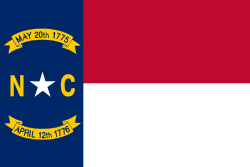Kinston, North Carolina
Kinston is a city in Lenoir County, North Carolina with a population of 21,677 as of the 2010 Census. It has been the county seat of Lenoir County since its formation in 1791.[4] Kinston is located in the coastal plains region of Eastern North Carolina. In 2009, Kinston won the All-America City Award. This marks the second time in twenty-one years the city has won the title, the last time being in 1988.[5]
Kinston, North Carolina | |
|---|---|
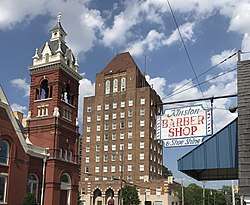 Queen Street United Methodist Church (left) and the Hotel Kinston (center) in Kinston | |
Location of Kinston within North Carolina. | |
| Coordinates: 35°16′14″N 77°35′6″W | |
| Government | |
| • Mayor | Dontario Hardy (D) |
| Area | |
| • Total | 16.9 sq mi (43.7 km2) |
| • Land | 16.7 sq mi (43.3 km2) |
| • Water | 0.2 sq mi (0.4 km2) |
| Elevation | 43 ft (13 m) |
| Population (2010) | |
| • Total | 21,677 |
| • Estimate (2018)[1] | 20,083 |
| • Density | 1,300/sq mi (500/km2) |
| Time zone | UTC−5 (EST) |
| • Summer (DST) | UTC−4 (EDT) |
| ZIP codes | 28501-28504 |
| Area code(s) | 252 |
| FIPS code | 37-35920[2] |
| GNIS feature ID | 0988015[3] |
| Website | http://www.ci.kinston.nc.us/ |
History
Early history
At the time of English settlement, the area was inhabited by the Neusiok Indians. Preceding the historic tribe, indigenous peoples of a variety of cultures had lived in the area for thousands of years. Before the English colonists established the city, they called the area Atkins Bank, referring to a bluff once owned by Robert Atkins just above the Neuse River. Atkins Bank was the site of farms, a tobacco warehouse, and a Church of England mission.
Kinston was created by an act of the North Carolina General Assembly in December 1762 as Kingston, in honor of King George III[6] who had just recently ascended to the throne. The bill to incorporate it was introduced by Richard Caswell, who made his home there and later served as the first Governor of the State of North Carolina from 1776 to 1780. After victory in the American Revolution, the citizens renamed the city Kinston in 1784 to show the population's disavowal of royalty. In 1833, Kinston briefly became Caswell, in honor of governor Richard Caswell, but the name was reverted to Kinston the following year.
Commissioners appointed to design the town began to accept "subscriptions" for numbered lots. To keep a lot, subscribers were required to build brick homes of specific dimensions within three years or lose their rights to the property. The town was laid out with border streets named East, North, and South, with the western border the Neuse River. The two principal roads within these borders were named for King George and Queen Charlotte. They remain King and Queen Street to this day. Other streets were named in honor of Governor Dobbs (later renamed Independent Street) and the commissioners.
In December 1791, an act was passed in the General Assembly to abolish Dobbs County and form Lenoir and Glasgow counties. At that time, Kinston was designated the county seat for Lenoir County.
Throughout this period, Kinston was an unincorporated town. It finally became incorporated through an act of the legislature in January 1849. Following incorporation, the population grew rapidly. In 1850, the population was estimated at 455 people, and just ten years later, it had more than doubled to over one thousand.
Civil War
During the onset of the American Civil War, Camp Campbell and Camp Johnston were established near the city as training camps, and a bakery on Queen Street was converted to produce hardtack in large quantities. There was also a factory for the production of shoes for the military located in Kinston. The Battle of Kinston took place in and around the city on December 14, 1862.
From February 5, 1864 to February 22, 1864 twenty-two deserters were executed by hanging in the city. The court martial and subsequent hanging was carried out by the 54th Regiment, North Carolina Troops, Confederate States Army. Fifteen of these men were from Jones County and had all started their service in the 8th Battalion North Carolina Partisan Rangers. The question begs to be asked is how so many men from one company could desert, join the union army, be captured, tried as traitors and executed by hanging. Four of the principals, excluding the 22 that were hung, are Colonel Nethercutt, commanding officer of the 8th Battalion (also the 66th Regiment), John Paris, the Chaplain of the 54th Regiment (the regiment responsible for carrying out the executions), Major General G. E. Pickett, CSA and John J Peck, Major General, Union.
The Battle of Wyse Fork aka 'Battle of Southwest Creek' (March 7–10, 1865) also occurred very near the city. It was at this later battle that the Confederate Ram Neuse was scuttled to avoid capture by Union troops. Remnants of the ship have been salvaged, and were on display at Richard Caswell Park on West Vernon Ave. A climate-controlled museum has been built on downtown Queen Street, and has moved the hulk there to prevent further deterioration of the original ship's remains. A full-scale replica vessel (Ram Neuse II) has been constructed near the original's resting place (known as the "Cat's Hole") beside the bank of the Neuse River on Heritage St. in Kinston. Union Army forces occupied the city following the battle.
United States troops were assigned to the area through the Reconstruction Era.
Post-Reconstruction
_-_DPLA_-_c0ebafb8180499bc6492e09ac6c64bf8_(page_77)_(cropped).jpg)
Despite the hardships of war and Reconstruction, the population of the city continued to grow. By 1870, the population had increased to eleven hundred people and grew to more than seventeen hundred within a decade.
During the late nineteenth century, there was expansion into new areas of industry, most notably the production of horse-drawn carriages. Kinston also became a major tobacco and cotton trading center. By the start of the twentieth century, more than five million pounds of tobacco were being sold annually in Kinston's warehouses. Along with the growth in population and industry was a growth in property values. Some parcels increased in value more than fivefold within a twenty-year period.
20th Century
New industries were founded, including lumber and cotton mills, as North Carolina businessmen invested in processing their own crops. Professional sports was introduced in the form of a minor league baseball team. Later growth would come in the form of a DuPont plant for the manufacture of polyester fibers, and manufacturing plants for pharmaceuticals. Growth finally slowed following the 1960s, with the shift in textile production overseas. Efforts to reinvigorate the economy through various means have had limited success.
Kinston was heavily impacted by flooding in 1996 and 1999. Hurricane Fran struck the North Carolina coast on September 5, 1996 and brought 16 inches (406 mm) of rain to the area.,[7] causing the Neuse River to flood portions of the city. On September 16, 1999, Hurricane Floyd struck the area, bringing 17 inches (430 mm) of rain. It caused what locals have called "The Flood of the Century."[8]
The National Register of Historic Places lists the American Tobacco Company Prizery, Atlantic and North Carolina Railroad Freight Depot, Baptist Parsonage, Robert L. Blalock House, B. W. Canady House, CSS Neuse, Hill-Grainger Historic District, Hotel Kinston, Jesse Jackson House, Kennedy Memorial Home Historic District, Kinston Apartments, Kinston Baptist-White Rock Presbyterian Church, Kinston Battlefield, Kinston Commercial Historic District, Kinston Fire Station-City Hall, Lenoir County Courthouse, Mitchelltown Historic District, Peebles House, Peoples Bank Building, Queen-Gordon Streets Historic District, Standard Drug No. 2, Sumrell and McCoy Building, Trianon Historic District, Tull-Worth-Holland Farm, and Dempsey Wood House.[9]
Demographics
| Historical population | |||
|---|---|---|---|
| Census | Pop. | %± | |
| 1850 | 455 | — | |
| 1860 | 1,333 | 193.0% | |
| 1870 | 1,103 | −17.3% | |
| 1880 | 1,216 | 10.2% | |
| 1890 | 1,726 | 41.9% | |
| 1900 | 4,106 | 137.9% | |
| 1910 | 6,995 | 70.4% | |
| 1920 | 9,771 | 39.7% | |
| 1930 | 11,362 | 16.3% | |
| 1940 | 15,388 | 35.4% | |
| 1950 | 18,336 | 19.2% | |
| 1960 | 24,819 | 35.4% | |
| 1970 | 23,020 | −7.2% | |
| 1980 | 25,234 | 9.6% | |
| 1990 | 25,295 | 0.2% | |
| 2000 | 23,688 | −6.4% | |
| 2010 | 21,677 | −8.5% | |
| Est. 2018 | 20,083 | [1] | −7.4% |
| U.S. Decennial Census[10] | |||
As of the 2010 United States Census, there were 21,677 people living in the city. The racial makeup of the city was 67.7% Black, 27.8% White, 0.2% Native American, 0.7% Asian, 0.1% Pacific Islander, 0.1% from some other race and 1.1% from two or more races. 2.4% were Hispanic or Latino of any race.
As of the census[2] of 2000, there were 23,688 people, 9,829 households, and 6,074 families living in the city. The population density was 1,415.7 people per square mile (546.7/km²). There were 11,229 housing units at an average density of 671.1 per square mile (259.1/km²). The racial makeup of the city was 35.27% White, 62.64% African American, 0.16% Native American, 0.57% Asian, 0.05% Pacific Islander, 0.66% from other races, and 0.67% from two or more races. Hispanic or Latino of any race were 1.14% of the population.
There were 9,829 households out of which 28.0% had children under the age of 18 living with them, 35.7% were married couples living together, 22.7% had a female householder with no husband present, and 38.2% were non-families. 34.5% of all households were made up of individuals and 16.4% had someone living alone who was 65 years of age or older. The average household size was 2.29 and the average family size was 2.94.
In the city, the population was spread out with 24.4% under the age of 18, 7.3% from 18 to 24, 24.9% from 25 to 44, 24.5% from 45 to 64, and 18.9% who were 65 years of age or older. The median age was 41 years. For every 100 females, there were 81.8 males. For every 100 females age 18 and over, there were 74.6 males.
The median income for a household in the city was $26,630, and the median income for a family was $35,867. Males had a median income of $28,688 versus $21,442 for females. The per capita income for the city was $17,779. About 19.7% of families and 23.0% of the population were below the poverty line, including 32.0% of those under age 18 and 18.9% of those age 65 or over.
Government and infrastructure
The North Carolina Department of Public Safety (formerly the North Carolina Department of Juvenile Justice and Delinquency Prevention) operates the Dobbs Youth Development Center juvenile correctional facility in Kinston. The facility, which opened in 1944, serves both boys. The prisoner capacity is 44.[11]
In the 2017 municipal elections, Democratic candidate Dontario Hardy beat incumbent B.J. Murphy by a margin of 205 votes.[12] City Councilman Robert A. Swinson IV was re-elected alongside newcomer Kristal Suggs, completing Kinston's first ever all African-American city council.[13]
Infrastructure

Health-care
Kinston is serviced by UNC Lenoir Health Care, a non-profit hospital located near NC 11 in Kinston. The hospital offers inpatient, outpatient and preventive healthcare services for the residents of Lenoir, Greene and Jones counties.
General services include general medical, surgical, obstetrical and gynecological care. Specialized services include cardiology, pulmonology, oncology, radiology, urology, and vascular surgery.
Transportation
Passenger
Kinston is not served directly by passenger trains. The closest Amtrak station is located in Wilson.
Air
Kinston is served by the Kinston Regional Jetport (IATA: ISO, ICAO: KISO). Raleigh-Durham International Airport is the closest major airport with service to more than 45 domestic and international destinations. Kinston Regional Jetport is the site from which Bill Harrelson of Fredericksburg, VA embarked and to which he returned on his Guinness world-record-setting "around-the-globe-over-the-poles" flight in his custom-built Lancair, N6ZQ over the time period Dec, 2014 - Jan, 2015.[14]
Road
- The main highway in Kinston is US 70, an east-west highway that provides access to the North Carolina coast as well as major cities to the west such as Raleigh and Greensboro and I-95.
- I-95 is the closest Interstate Highway to Kinston.
- Other highways that serve Kinston include US 258, NC 11, NC 58, NC 55, and NC 148.Bus: Kinston is served by Greyhound.
Religion
As with most of North Carolina, Kinston is predominately Protestant with large concentrations of Baptists, Methodists, and various other evangelical groups. Episcopalians, Presbyterians, and Disciples of Christ also constitute a significant portion of the population.
The Roman Catholic community in Kinston has seen steady growth over the years with the migration of Hispanic workers to the area. Also, Catholic migrants have come from the northeastern United States who work for the North Carolina Global TransPark and in nearby Greenville, North Carolina.
Kinston at one time had a sizeable Jewish community. As with most Jewish communities in the rural South, it has seen a steady decline. Temple Israel, Kinston's only synagogue, has only a few remaining members.[15]
Education
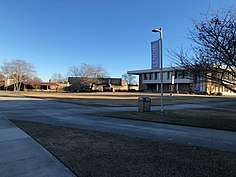
Public college
- Lenoir Community College
Private college
- United American Free Will Baptist Bible College
Public schools
- Kinston High School
- Lenoir County Early College
- Contentnea-Savannah School
- Children's Village Academy
- Rochelle Middle School
- Woodington Middle School
- Banks Elementary School
- Northwest Elementary School
- Moss Hill Elementary School
- Southeast Elementary School
- Southwood Elementary School
- Northeast Elementary School
Private schools
- Arendell Parrott Academy, a non-sectarian private school (K-12)
- Bethel Christian Academy, a Christian private school (K-12)
Culture
Arts and Theater
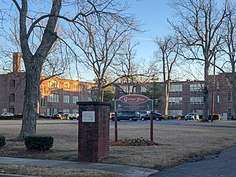
One of Kinston's most notable buildings is the Grainger Hill Performing Arts Center, formerly Grainger High School. Constructed in 1924 after a fire destroyed the previous Kinston High School building, the school was named after Jesse W. Grainger - a local truck farmer who owned the land that the school was built upon and donated money to fund one-half of the building's $182,340 general contractor's fee. After the decision in 1970 to make way for the newly constructed and integrated Kinston High School, it served as Kinston Jr. High School until 1987 (when 9th grade students were moved to the campus of Kinston High School and 8th grade students were relocated to the campus of Rochelle Middle School). After the school's closure, the building was sold to a private developer who renovated the school and turned it into a performing arts center. The property was most recently sold to The Landmark Development Group, who has renovated the building into Grainger Elderly Housing, a fifty-seven unit apartment complex for low-income elderly residents.
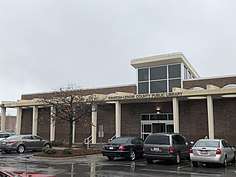
Tourism and Recreation
The Neuse Regional Library system is headquartered in Kinston and operates branches in Kinston, LaGrange, Pink Hill, as well as locations in Greene and Jones Counties.[16]
Kinston is also home to the CSS Neuse which is listed on the National Register of Historic Places,[9] which has its remains on display in the CSS Neuse Civil War Interpretive Center. The Lenoir County Confederate Memorial, the Caswell family cemetery, and the Lenoir County Korean and Vietnam War Memorial are located nearby. There is also a Civil War Trails marker.[17]
The Cultural Heritage Museum (CHM), built in 2000 on South Queen Street as a new economic development catalyst for Kinston and the surrounding areas of eastern North Carolina, was created to recognize the contributions of African Americans in numerous fields. It pays tribute to the more than 200,000 black soldiers and 7,000 white officers of the United States Colored Troops who fought with the Union forces in the American Civil War. It also honors black military veterans from all wars, Carl Long and the Negro Baseball League players, local heroes, and Africa and Black History in general. The CHM intends to generate jobs and promote economic expansion opportunities.[18]
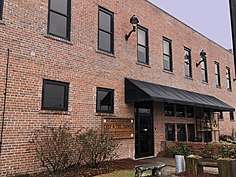
Kinston is also home to several notable restaurants. The Chef & the Farmer, recipient of James Beard Award, started by Vivian Howard and Ben Knight is located in downtown Kinston. The PBS series A Chef's Life focuses on the restaurant, owners, and local farmers it sources from like Brothers Farm. The Barn Steakhouse and The Baron & the Beef are also both fine dining establishments featuring locally sourced produce and meats on their menus while supporting sustainable agriculture. Also a proponent of sustainable practices and local ingredients, Mother Earth Brewing was founded in Kinston in the summer of 2008.
Other notable businesses and restaurants include The Overland Gallery, Ginger 108, The Boiler Room, the O'Neil Bed and Breakfast, the Bentley B&B, and the Lenoir County Farmers Market.
Other local attractions include the Neuseway Nature Center and Planetarium, the Kinston Country Club, the Kinston Center for the Arts, the Global Transit Park (GTP), Grainger Stadium, the Caswell Center, and Lenoir Memorial Hospital.
Annual festivities in Kinston include the Sand in the Streets concert series held at Pearson Park, the Annual BBQ Festival on the Neuse River, and the Festival on the Neuse.
Sports
Kinston's Grainger Stadium is home to the Down East Wood Ducks, a Class A-Advanced Minor League Baseball team in the Carolina League that began play in 2017.[19]

It was previously home to the Kinston Indians minor league baseball team, as well as youth and college level baseball tournaments. The town first hosted professional baseball in 1908 and among the many alumni is Rick Ferrell, who was inducted into the Baseball Hall of Fame, Manny Ramirez and Lonnie Chisenhall.[20]
The Kinston Drag Strip hosts a variety of motor sports events throughout the year. Kinston also has three golf courses: the Kinston Country Club, Falling Creek Country Club, and the Bill Fay Park Par 3 Golf Course. Barnet Park is home to a disc golf course. The "Galaxy of Sports" is a recreational facility including a bowling alley, skating rink, and a health club.
In 2012, Woodmen of the World constructed the Woodmen of the World Community Center and Lions Water Adventure Park, a 53,000 sq ft (4,900 m2) facility that offers a cardio and strength training center, an Olympic-sized swimming pool, several corporate reception areas and conference rooms, as well as a quarter-mile elevated track and several sporting courts. The center is now owned by the city of Kinston and is called the "Kinston Community Center".
In 1956, Kinston was the site of a rare, perfect game of billiards, as Willie Mosconi sank 150 balls in a row in one inning against Jimmy Moore.[21]
In 2018, ESPN called Kinston, "America's Basketball Heaven." According to the ESPN article, 1 in 52.7 players on Kinston High School's varsity team make the NBA.[22]
Parks and recreation
The city contains the following parks:[23]
- Neuseway Nature Park, Campground, and Meeting Facility
- Pearson Park
- Bill Fay Memorial Park
- Emma Webb Park
- Fairfield Park
- Holloway Park
- Lovit Hines Park
- Southeast Park
- Barnet Park
- Lions Adventure Water Park
Notable people
- Larry Beck, professional golfer[24]
- Jocelyn Brown, singer[25]
- James Tim Brymn, jazz musician
- Morgan Brian, professional female football player
- Reggie Bullock, NBA player for the New York Knicks
- Carter Capps, All-America baseball player at Mt. Olive College and MLB relief pitcher
- William Caswell (military general), Revolutionary War general
- Dwight Clark, retired NFL receiver for San Francisco 49ers, noted for The Catch
- Quinton Coples, defensive end formerly of the New York Jets
- Richard Cray, singer
- Tony Dawson, retired NBA player
- Ed Grady, actor[26]
- Chris Hatcher, MLB pitcher[27]
- Brandon Ingram, NBA player for the New Orleans Pelicans
- Malcolm Howard, federal judge[28]
- Vivian Howard, chef[29]
- Danny (Joe) Humphrey, retired Bassmaster Champion
- Cedric "Cornbread" Maxwell, retired NBA player[30]
- Mitchell's Christian Singers, gospel group[31]
- Robert 'Brother Ah' Northern, jazz musician, educator, radio host[32]
- Susan Owens, Washington State Supreme Court Justice
- Maceo Parker, musician
- Melvin Parker, drummer
- Marion A. Parrott, lawyer, activist
- Jaime Pressly, actress, model[33]
- Barbara Roy, singer
- Ted Sampley, Vietnam veteran and POW-MIA activist
- Christa Sauls, actress, model
- Charles Shackleford, retired NBA player
- J. Carlyle Sitterson, educator
- Tab Smith, swing saxophonist
- Frank Snepp, journalist
- Jerry Stackhouse, retired NBA player
- George Suggs, MLB pitcher
- Tyrone Willingham, college football coach
- Mitchell Wiggins, retired NBA player
- Steve Cowper, Former Governor of Alaska
See also
- West Pharmaceutical Services explosion
Bibliography
- Cooper, Edwin B., Jr., et al. (eds.) (1981). The Heritage of Lenoir County. The Lenoir County Historical Association. ISBN 0-89459-155-X.CS1 maint: multiple names: authors list (link) CS1 maint: extra text: authors list (link)
- Johnson, Talmage C.; Charles R. Holloman (1954). The Story of Kinston and Lenoir County. Edwards and Broughton Company. ASIN B000FRTZB8.
- Kohler, Mike (1976). 200 Years of Progress: A Report of the History and Achievements of the People of Lenoir County, 1776-1976. Kinston-Lenoir County Bicentennial Commission. ASIN B0006CVK5G.
- Little, M. Ruth; Robbie D. Jones (1998). Coastal Plain and Fancy: The Historic Architecture of Lenoir County and Kinston, North Carolina. The Lenoir County Historical Association. ISBN 0-9668319-0-X.
- Powell, William S. (1963). Annals of Progress: The Story of Lenoir County and Kinston, North Carolina. State Department of Archives and History. ISBN 0-86526-124-5.
References
- "Population and Housing Unit Estimates". Retrieved July 29, 2019.
- "U.S. Census website". United States Census Bureau. Retrieved 2008-01-31.
- "US Board on Geographic Names". United States Geological Survey. 2007-10-25. Retrieved 2008-01-31.
- "Find a County". National Association of Counties. Archived from the original on 2011-05-31. Retrieved 2011-06-07.
- "Overview". ENC Today Website. 2009-06-20. Archived from the original on 2011-07-10.
- Gannett, Henry (1905). The Origin of Certain Place Names in the United States. Govt. Print. Off. p. 176.
- Hurricane Fran - September 3-9, 1996
- North Carolina School Video Catalog Archived 2008-07-23 at the Wayback Machine The Neuse River (35.270676, -77.585130)
- "National Register Information System". National Register of Historic Places. National Park Service. July 9, 2010.
- "Census of Population and Housing". Census.gov. Retrieved June 4, 2015.
- "Youth Development Centers Archived 2015-12-22 at the Wayback Machine." North Carolina Department of Public Safety. Retrieved on December 16, 2015. "Dobbs Youth Development Center 3060 Dobbs Farm Road Kinston, N. C. 28504"
- "NC SBE Election Contest Details". er.ncsbe.gov. Retrieved 2017-12-05.
- Oliver, Edward Sheehy/Lindsay. "Kinston council is sworn in marking historic day". Retrieved 2017-12-05.
- Sullivan, Paul (2015-01-25). "Stafford pilot Bill Harrelson flies around the world in small plane". The Free Lance-Star. Archived from the original on 2018-01-29. Retrieved 2018-01-29.
- "Temple of Israel, Kinston". Retrieved 29 July 2019.
- Branch Libraries of the Neuse Regional Library System Archived 2008-03-19 at the Wayback Machine
- CSS Neuse State Historic Site Archived 2008-02-29 at the Wayback Machine
- "Culturalheritagemuseum.Org". Archived from the original on 2015-11-16. Retrieved 2008-02-28.
- Speddon, Zach (August 23, 2016). "Excitement Builds in Kinston". Ballpark Digest. Retrieved September 20, 2016.
- Dalimonte, David E. "Kinston Has a Rich Tradition in Baseball". Retrieved 2008-03-20.
- ""Willie Mosconi, 80, Who Ruled The World of Billiards With Style", New York Times". The New York Times. September 18, 1993.
- "How Kinston, North Carolina Became Greatest Producers of NBA Talent". ESPN. Retrieved 21 February 2018.
- Lenoir County North Carolina Parks
- English, John (August 1957). "AN HOSPITABLE CLUB AND A FINE YOUNG PLAYER" (PDF). USGA JOURNAL AND TURF MANAGEMENT – via Michigan State University.
- "Dance-music legend Jocelyn Brown on family, music and living in England ahead of St Albans show Soul Box: Back in the Day". St Albans Review. 2015-03-18. Archived from the original on 2015-06-09. Retrieved 2018-01-26.
- "Edward Louis "Ed" Grady – obituary". The Cherokee One Feather. December 13, 2012. Retrieved July 25, 2016.
- Hendrickson, Brian (2002-11-27). "Baseball Team adds Versatility". Star News Online. Archived from the original on 2017-02-18. Retrieved 2018-01-26.
- "Howard, Michael Jones". Federal Judicial Center. 2018-01-26. Archived from the original on 2017-08-22. Retrieved 2018-01-26.
- "A Chef's Life: Vivian Howard". Southern Living. Retrieved 29 July 2019.
- "Cedric Maxwell - 98.5 The Sports Hub Color Analyst". NBA.com. 2018-01-26. Archived from the original on 2017-04-15. Retrieved 2018-01-26.
- Bryan, Sarah (2013). African American Music Trails of Eastern North Carolina. UNC Press Books. pp. 19–21. ISBN 1469610795.
- Richards, Chris (2013-04-26). "Brother Ah: A lifetime of jazz on local radio". The Washington Post. Archived from the original on 2018-01-26. Retrieved 2018-01-26.
- "Jaime Pressly". TV Guide. Retrieved 29 July 2019.
External links
| Wikimedia Commons has media related to Kinston, North Carolina. |
- Official website
- Kinston Chamber of Commerce
- Kinston Convention & Visitors Bureau
- Neuse Regional Library
- CSS Neuse and Caswell Memorial
- Cultural Heritage Museum

